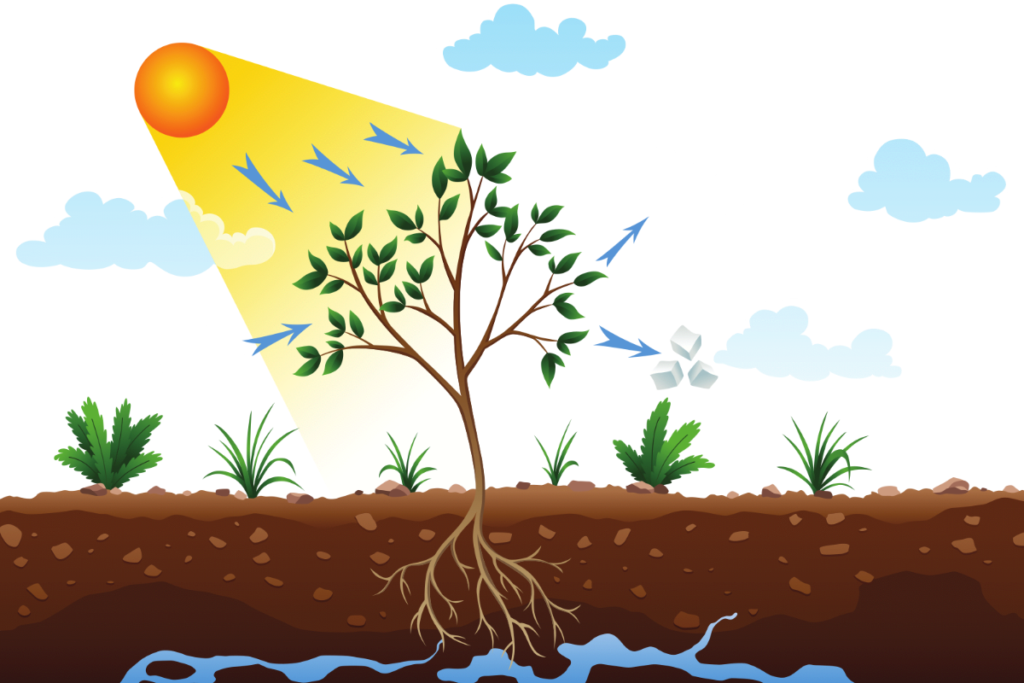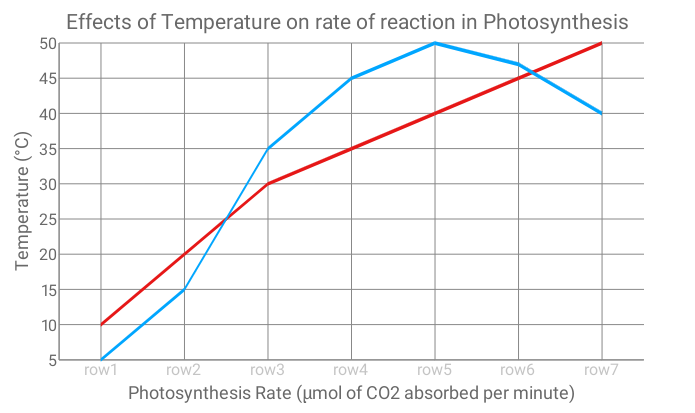Green plants, algae, and certain bacteria utilize photosynthesis, an important biological process that converts carbon dioxide (CO2) and water (H2O) into glucose and oxygen (O2) using energy from sunlight. This process plays a crucial role in sustaining life on Earth by fueling plant growth and survival. Here’s a simplified breakdown of how this process works:
Absorption of Light
In the presence of sunlight, specialized pigments in plant cells, primarily chlorophyll, absorb photons of light energy. Chlorophyll is what gives plants their green color.
Light Energy Conversion
The absorbed light energy is converted into chemical energy, which is used to power the process of photosynthesis. The products for this food-making process, which represent the process by which plants, algae, and some bacteria convert light energy into chemical energy, are as follows:
6 CO2 + 6 H2O + light energy → C6H12O6 (glucose) + 6 O2

Splitting of Water
During the first stage of Food-making, known as the light-dependent reactions, water molecules are split into oxygen and protons (H+ ions) within the chloroplasts of plant cells. This process releases oxygen into the atmosphere as a byproduct.
Production of ATP and NADPH
The energy obtained from the absorbed light is used to create two important molecules: adenosine triphosphate (ATP) and nicotinamide adenine dinucleotide phosphate (NADPH). These molecules store and transport the chemical energy needed for the next stage of photosynthesis.

Carbon Fixation
In the second stage, known as the light-independent reactions or the Calvin cycle, carbon dioxide from the atmosphere is “fixed” into organic molecules. ATP and NADPH produced in the previous stage are used to convert carbon dioxide into glucose and other organic compounds.

Glucose Production
The glucose and other organic molecules created through the Calvin cycle serve as the plant’s source of energy and as building blocks for its growth and development.
It is critical for several reasons:
Oxygen Production
It’s a primary source of the oxygen we breathe, as oxygen is released into the atmosphere as a byproduct of the water-splitting process.
Food Production
Photosynthesis is the foundation of the food chain. Plants create their own food, and herbivores (plant-eating animals) rely on them for sustenance, while carnivores and omnivores depend on these herbivores.
Carbon Cycle
It plays a pivotal role in regulating the balance of carbon dioxide in the atmosphere, which is essential for Earth’s climate stability.
Energy Source
This process powers ecosystems and is also the source of fossil fuels, which provide much of the world’s energy.
Environmental Balance
It contributes to maintaining ecological balance and diverse habitats, supporting a wide range of organisms.
Furthermore, photosynthesis is in the table below:
| Importance of Photosynthesis | Explanation |
|---|---|
| Oxygen Production | It is responsible for generating approximately half of the oxygen in the Earth’s atmosphere as a byproduct. |
| Food Production | It forms the foundation of the food chain, as plants and algae, the primary photosynthesizes, serve as a source of food for other organisms. |
| Carbon Cycling | It helps regulate Earth’s carbon cycle by removing carbon dioxide from the atmosphere and converting it into organic compounds. |
| Energy Source | Fossil fuels, derived from ancient plant material that underwent photosynthesis, remain a major source of energy. Renewable biofuels and biomass also rely on recent photosynthesis. |
| Environmental Balance | It contributes to maintaining ecological balance by supporting diverse ecosystems and habitats. |
| Crop Productivity | Understanding and optimizing photosynthesis in crops is crucial for increasing agricultural productivity and ensuring food security. |
| Climate Change Mitigation | It can play a role in mitigating climate change by sequestering carbon dioxide from the atmosphere. |
| Scientific Research | Photosynthesis is a subject of extensive scientific study, offering insights into plant biology, biochemistry, and environmental science. |
Rate of reaction and factors affecting the rate of reaction in Photosynthesis
The rate of photosynthesis, or the speed at which photosynthesis occurs, can be influenced by various factors. These factors include:
1. Light Intensity
An increase in light intensity generally leads to a higher rate of photosynthesis until a certain saturation point is reached. Beyond this point, further increases in light intensity do not significantly boost the rate.

2. Carbon Dioxide (CO2) Concentration
An increase in the concentration of carbon dioxide usually results in a higher photosynthesis rate, provided that other factors like light and temperature are not limiting.
3. Effects of Temperature on the rate of reaction in Photosynthesis
Photosynthesis rates tend to increase with higher temperatures, up to a certain optimal range. Beyond this range, it can be inhibited or become less efficient.

This table shows how the rate of photosynthesis increases with higher temperatures, up to an optimal range of around 40°C. Beyond this range, the rate starts to decline. The data is for illustrative purposes and can vary depending on the plant species and experimental conditions.
4. Water Availability
Adequate water supply is essential for photosynthesis. Water scarcity can limit the rate of photosynthesis.
5. Chlorophyll and Pigment Availability in Photosynthesis
The presence of chlorophyll and other pigments in plants is crucial for capturing light energy. Any factors that affect pigment availability can influence the photosynthesis rate.
6. Nutrient Availability
Plants require various nutrients, such as nitrogen, phosphorus, and potassium, for photosynthesis. Nutrient deficiencies can limit the rate of photosynthesis.
7. Environmental Stress
Environmental stresses like drought, pollution, and disease can hinder food-making processes by damaging plant tissues or disrupting cellular processes.
8. Enzyme activity
The rate of photosynthesis, a complex biochemical process, can be influenced by enzyme activity. Enzymes play a crucial role in catalyzing the various reactions involved in photosynthesis. Here are some effects of enzyme activity on the rate of photosynthesis:
(a). Temperature Dependence
Enzyme activity is highly temperature-sensitive. At lower temperatures, enzymes function less efficiently, which can limit the rate of photosynthesis. As temperature increases within an optimal range, enzyme activity and photosynthesis rate generally increase. However, excessively high temperatures can denature enzymes, causing a decline in this process.
(b). pH Levels
Enzymes have specific pH optima at which they work most effectively. In the food-making process, several enzymes are involved in carbon fixation and the Calvin cycle. Any significant deviation from the optimal pH range for these enzymes can hinder their activity and reduce the photosynthesis rate.
(c). Enzyme Availability
The availability of enzymes and coenzymes (molecules that assist enzymes) can impact photosynthesis. Adequate levels of enzymes such as ribulose-1,5-bisphosphate carboxylase/oxygenase (RuBisCO) are crucial for the carboxylation of ribulose-1,5-bisphosphate, a key step in carbon fixation.
(d). Substrate Concentration
Enzymes require an adequate concentration of substrates (reactants) to function optimally. In the food-making process, an increase in the concentration of carbon dioxide (CO2), a substrate, can lead to a higher rate of carbon fixation and, consequently, increased photosynthesis, assuming other factors like light and temperature are not limiting.
(e). Inhibition
Some substances can inhibit enzyme activity. For example, certain herbicides can target enzymes involved in the food-making process, leading to a decrease in the rate of the process. Conversely, the presence of activators or coenzymes can enhance enzyme activity and potentially boost photosynthesis.
(f). Light Activation
Sunlight can influence enzyme activity indirectly by providing the energy needed for photosynthesis. Light energy absorbed by pigments, such as chlorophyll, triggers electron transport and ATP synthesis, indirectly affecting enzyme function during light-dependent reactions.
Conclusion
Photosynthesis is a biological marvel that sustains life and plays a central role in shaping our planet’s environment. It’s a reminder of the intricate web of interactions that make life on Earth possible and a testament to the wonders of nature’s chemistry. As we continue to explore and understand it, we uncover new possibilities for sustainable living and a deeper appreciation for the natural world.
FAQs
It is a vital biological process in which green plants, algae, and some bacteria use sunlight to convert carbon dioxide and water into glucose (sugar) and oxygen. This process provides energy and sustenance for these organisms while releasing oxygen into the atmosphere.
This process primarily occurs in the chloroplasts of plant cells, specifically in the chlorophyll-containing thylakoid membranes. Algae and some bacteria also have similar structures for photosynthesis.
Chlorophyll is a green pigment found in chloroplasts. It plays a crucial role in the food-making process by absorbing light energy and initiating the conversion of that energy into chemical energy.
Reactants: Carbon dioxide (CO2) and water (H2O)
Products: Glucose (C6H12O6) and oxygen (O2)
This is essential because it produces oxygen, which is necessary for aerobic respiration in plants and animals. It also serves as the foundation of the food chain, providing energy and sustenance for all life forms on Earth.
No, it requires light energy to occur. Light is essential for the excitation of electrons in chlorophyll, initiating the process.
Yes, factors such as light intensity, temperature, water availability, and the concentration of carbon dioxide can influence its rate. Climate change can alter these factors and impact photosynthetic rates in plants.